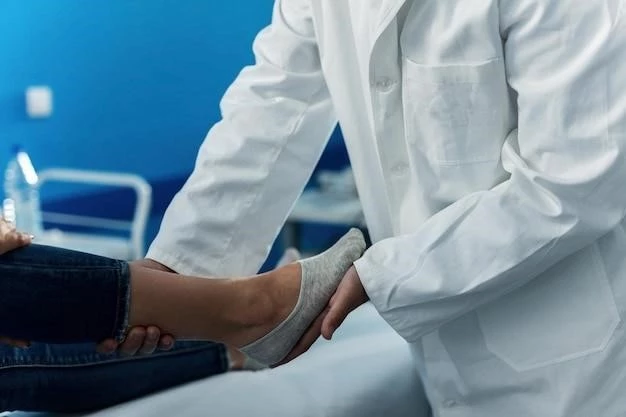Macrodactyly of the Foot
Macrodactyly of the foot is a rare condition characterized by abnormal growth and enlargement of the digits. This article will explore the symptoms, causes, diagnosis, treatment options, surgical procedures, recovery process, risks, living with the condition, research, support networks, and conclude with valuable insights.
Introduction
Macrodactyly of the foot is a rare condition where there is abnormal enlargement and growth of one or more toes or the entire foot. This abnormality can lead to swelling, pain, and discomfort for those affected. Understanding the symptoms, causes, diagnosis, treatment options, surgical procedures, recovery process, risks, and living with this condition are essential for individuals diagnosed with it. Through advancements in research and support networks, individuals with macrodactyly can find solace, treatments, and improved quality of life.
Symptoms of Macrodactyly
The key symptoms of macrodactyly of the foot include noticeable swelling and abnormal enlargement of toes or the entire foot. Individuals may experience pain and discomfort due to the increased size of the affected area. In severe cases, the condition can impact mobility and cause emotional distress. Understanding these symptoms is crucial for an accurate diagnosis and timely intervention to manage the effects of macrodactyly.
Causes of Macrodactyly
The exact cause of macrodactyly of the foot is not entirely understood, but it is believed to be a congenital anomaly that occurs during fetal development. Some cases may be associated with genetic mutations or overgrowth of tissue in the affected digit or foot. Factors such as abnormal cell growth or changes in certain genes could contribute to the abnormal enlargement observed in macrodactyly. Further research is needed to elucidate the precise mechanisms behind the development of this rare condition.
Diagnosis of Macrodactyly
Diagnosing macrodactyly of the foot typically involves a thorough physical examination by a healthcare professional. Imaging tests such as X-rays, MRIs, or CT scans may be utilized to visualize the abnormal growth patterns and assess the extent of enlargement. A detailed medical history review and evaluation of symptoms are crucial for an accurate diagnosis. Genetic testing may also be recommended in some cases to identify any underlying genetic factors contributing to the condition. Early and precise diagnosis is essential for determining the most suitable treatment approach for individuals with macrodactyly.
Treatment Options
When it comes to treating macrodactyly of the foot, several options are available depending on the severity of the condition. Non-surgical interventions such as orthotic devices, physical therapy, and pain management techniques can help alleviate symptoms and improve functionality. In cases where conservative methods are insufficient, surgical procedures may be recommended to reduce the abnormal enlargement and restore the normal appearance and function of the foot. The decision on the most appropriate treatment plan is based on individual factors such as the extent of enlargement, symptoms experienced, and overall health status.
Surgical Procedures
For individuals with macrodactyly of the foot, surgical intervention may be recommended to address the abnormal growth and restore function. Surgical procedures for macrodactyly typically involve debulking the excess tissue, reducing the size of the affected digits or foot, and reshaping the structures to improve symmetry and function. Surgeons may utilize techniques such as soft tissue reduction, bone reshaping, or joint stabilization to achieve optimal outcomes. The specific surgical approach adopted will depend on the individual’s unique presentation and goals for treatment. Close collaboration between the medical team and the patient is essential in planning and executing the most effective surgical procedure.
Recovery Process
The recovery process following surgical treatment for macrodactyly of the foot is crucial for optimal outcomes. Patients may experience varying degrees of discomfort, swelling, and limited mobility in the initial post-operative period. Following post-operative care instructions, including wound care, pain management, and physical therapy, is essential for promoting healing and regaining function. Regular follow-up appointments with healthcare providers will allow for monitoring progress, addressing any concerns, and adjusting the treatment plan as needed. Adhering to the recommended rehabilitation protocol and engaging in activities that promote recovery can support a successful and smooth recovery process for individuals undergoing surgical treatment for macrodactyly.
Risks and Complications
While surgical procedures offer the potential for improving the function and appearance of the foot affected by macrodactyly, they also come with inherent risks and possible complications. Risks associated with surgery may include infection, poor wound healing, nerve damage, or recurrence of abnormal growth. Complications such as scarring, changes in sensation, or prolonged recovery time can also occur. It is essential for individuals considering surgical intervention for macrodactyly to discuss the potential risks and complications with their healthcare team and weigh them against the benefits of the procedure. Close monitoring and prompt management of any complications that arise are crucial for ensuring successful treatment outcomes.
Living with Macrodactyly
Living with macrodactyly of the foot can present unique challenges, both physically and emotionally. Individuals affected by this condition may experience difficulties with mobility, finding appropriate footwear, and managing discomfort on a daily basis. Psychological aspects such as self-esteem and body image may also be impacted. Building a strong support network, including healthcare providers, family, and support groups, can provide valuable assistance and encouragement. Developing coping strategies, exploring adaptive devices, and engaging in activities that promote physical and emotional well-being can help individuals with macrodactyly lead fulfilling lives despite the challenges posed by the condition.
Research and Innovations
Ongoing research in the field of macrodactyly of the foot is focused on advancing our understanding of the underlying causes, improving diagnostic methods, and developing innovative treatment approaches. Scientists and healthcare professionals are exploring genetic factors, molecular mechanisms, and potential targeted therapies to address this rare condition more effectively. Innovations in surgical techniques, such as minimally invasive procedures and tissue engineering, aim to enhance treatment outcomes and reduce the impact of surgery on patients. Collaboration between researchers, clinicians, and individuals with macrodactyly is instrumental in driving progress and fostering new discoveries that can positively impact the lives of those affected by this unique foot disorder.
Support Networks
For individuals living with macrodactyly of the foot, connecting with support networks can offer valuable resources, guidance, and emotional support. Support groups, online forums, and advocacy organizations dedicated to rare conditions can provide a sense of community and understanding for those affected by macrodactyly. These networks allow individuals to share experiences, seek advice, and access information on the latest treatments and research developments. Support networks also play a crucial role in raising awareness about macrodactyly, reducing stigma, and advocating for better care and services for individuals with this condition. Engaging with support networks can empower individuals with macrodactyly to navigate their unique challenges and lead fulfilling lives.

Conclusion
In conclusion, macrodactyly of the foot is a rare condition characterized by abnormal growth and enlargement of the digits. Understanding the symptoms, causes, diagnosis, treatment options, surgical procedures, recovery process, risks, and living with this condition is essential for individuals affected by macrodactyly. Through ongoing research, innovations in treatment approaches, support networks, and a multidisciplinary approach to care, individuals with macrodactyly can receive the necessary support and resources to manage their condition and enhance their quality of life. By raising awareness, fostering collaboration, and providing comprehensive care, we can better address the challenges posed by macrodactyly and support those living with this unique foot disorder.
